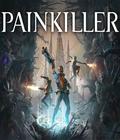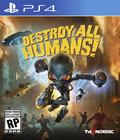Nostalgia is a weird thing. We cherish the gaming memories of our youth, but what seemed like a great experience at the time falters upon re-examination. Thankfully, THQ Nordic has been frantically buying up and either remastering or continuing old franchises. One of these efforts is Destroy all Humans!, a series that had a decent following after two releases on PS2 and Xbox in 2005 and 2006 and a largely forgettable sequel. The 2020 version is a full remake of the original release, complete with a graphical overhaul and improved gameplay. However, just like similar efforts before it, what's new in the remake doesn't detract from the fact that you're playing a game that was designed over 15 years ago.
Destroy all Humans! was originally created by Pandemic, which is most known for the original Star Wars: Battlefront series and its distinct taste for destruction in video games. Destroy all Humans! is also one of its most descriptive titles, since the game is literally about destroying humanity. The Furons, an alien race, are running into issues with their cloning efforts and need to refresh their DNA repertoire. Thankfully, humans carry pure Furon DNA in their genetic code, so Earth is a pristine DNA farm. After our clone brother, Crypto-136, is captured in Area 42, it's our job as Crypto-137 to avenge him. Things aren't a cakewalk, and several government agencies oppose our invasion. It's a simple premise that boils down to wreaking havoc upon humans and their cities.
Since DAH is a remake, you'll find the same story as the original. The voice acting hasn't been updated, so the voice work in the cut scenes and gameplay remains the same. The animations and graphics have been completely overhauled, giving everything a much sharper and expressive facade. The game retains all previous missions and recovers a completely new area (Area 42) with a handful of missions and challenges that were scrapped from the original release. That certainly looks like a valid approach on paper, but it doesn't look as great in action.
The game takes place across six different areas that are best described as open-world sandboxes within the U.S.: Area 42, a city, a farm, a suburban town, and even the national capitol. The game has a decent variety of environments that are visually distinct and fun to explore. If you've played the original, these areas will feel immediately familiar and, apart from the updates, play the same.
As Crypto-137, we are thrown into these sandboxes to advance the story, complete challenges, or cause an unholy amount of explosive chaos. It's an exciting notion — being an almighty alien with sci-fi weapons and psychic abilities in the 1950s. The game didn't take itself seriously, but it was committed to providing a fun experience. In a world where Saints Row didn't exist yet, DAH provided a lot of goofy fun that wasn't available elsewhere.
Times have certainly changed, and while I still consider DAH to be a great game concept, this remake didn't convince me that it needed to return in this form. It even comes with a warning label that this is the original experience in terms of content and writing, and that does rear its head on several occasions. The jokes haven't aged particularly well — I'd argue that most weren't great to start with — unless you enjoy being mistaken as a "midget" by enemies over and over again, since the dialogue gets repetitive in the game. If you've played the original, this likely won't be a surprise.
What's similarly irritating by today's standards is DAH's mission structures and designs. Most missions rarely take longer than a couple of minutes and don't provide much of a challenge. That seems partly to be caused by Crypto's enhanced combat abilities in this remake. The little gray alien is more versatile and powerful than he used to be, with improved jet pack abilities that catapult you into the air and onto rooftops much easier and with better precision. Crypto can also glide in mid-air while shooting at foes, so that adds a great deal of verticality to the combat. It doesn't end there, either, with a much more powerful dash ability and the ability to glide at a much faster speed.
The point of the game is still to collect human DNA, which usually means extracting human brains. This used to be a fun activity, but it's now incredibly overpowered due to the upgrades that string the extractions to nearby humans. Early on in the game, extracting a human brain can be a quicker way to deal with large groups rather than engaging in combat. It's still senseless fun to lead humanity on a merry dance of death and destruction.
The game tries to mix things up with some quieter moments. Crypto's psychic abilities mean we can influence humans and copy their appearance to remain undetected in a mission or the open world. This Holobob feature still works quite well, but its use feels inherently limited. There are some missions that require a silent approach where the Holobob functionality is mandatory, but unless the game instructs you otherwise, rushing in with brute force is the most fun and effective way to deal with situations.
I'm aware this is exactly what the original did, but the hard truth is that most of it gets old very quickly. It is more difficult to sneak by than to shoot your way through missions, so that often pushes players to a louder approach. This deals a blow to the mission variety, since we're repeatedly performing the same tasks: collecting, destroying, taking the form of a human, or making characters follow you. Your flying saucer can flatten a house in seconds, but apart from spectacular explosions, the missions rarely go beyond causing as much destruction as possible within a limited time.
What will most likely hamper your enjoyment is the quality of the gameplay. While Crypto plays wonderfully with a huge selection of psychic abilities to take on a human form, read minds, and manipulate humans, the weapon arsenal has stayed the same, with only four weapons to choose from. I would've loved to see some original guns or weapons from the sequel find their way here for some variety, especially since enemies don't provide much of a dynamic challenge.
The AI is as basic as it was in 2005, with no refined logic to an enemy's approach and no way of taking cover or flanking you; they mindlessly run to or away from you, so they're easy cannon fodder. There are stronger special forces, mech enemies, and military weaponry that can dish out good damage, but without any meaningful way to react to your actions, these encounters feel like a pushover. The few boss battles can be challenging, especially if you haven't upgraded the right abilities, but the sudden difficulty spike feels surprising based on the campaign prior to these encounters. It also doesn't provide much incentive to play the game after the final credits roll.
You can return to the open worlds and complete some of the challenges (usually four per area and a collectible drone), but since the final missions reward you with a lot of DNA, you'll be able to substantially upgrade Crypto to a point where there isn't a lot to gain from revisiting past challenges. The game introduces a few extra skins that can be unlocked, and missions can be retaken to complete optional side-quests, but given the low difficulty level, that is hardly an enticing premise.
Technically, everything looks much sharper and detailed, but it doesn't reach the heights that it could have. In many stretches, the game can feel like a PS2 title with slightly above-average PS3 visuals coated on top. While the overdrawn character models fit the "dense mid 1950s American society" stereotype to an almost hurtful degree, animations and some textures don't look up to snuff. It also has a very buggy tendency, which it likely retained from the original game, such as some noticeable clipping situations. For example, we failed one of the earlier missions due to a target we had to eliminate getting agitated enough to run through solid walls and then getting stuck inside a building structure, never to be seen (or brained) again. The game doesn't run smooth consistently, especially cut scenes that showcase a noticeable stutter on a number of occasions. Add to that the dated voice acting that repeats itself, and the game feels much more outdated than it had to be by 2020 standards.
If you can put all of that aside or appreciate Destroy All Humans! in a state that is undoubtedly close to how it played back in the day, there is a lot of fun to be in the PS4 remake. The combat is responsive, colorful, and over the top, and it lends itself well to short bursts of entertaining chaos. The same goes for its saucer gameplay; blowing up tiny buildings is not going to get old anytime soon. The title hasn't aged well, but it still possesses a certain charm. Maybe I was expecting too much, but I think I've raised some fair points. If you know and love the original, this PS4 remake is a great way to revisit the game. If you haven't played the original, the DAH remake feels difficult to recommend on its own; the two originals, which were remastered on current consoles in 2016, might be a better way for newcomers to test the waters without paying a premium.
Score: 6.5/10
More articles about Destroy All Humans!











 Destroy All Humans! is an action-adventure set in well-known locations spread across 1959 America, following Crypto's assault on mankind and the U.S. government’s attempt to disguise his alien invasion as a communist plot.
Destroy All Humans! is an action-adventure set in well-known locations spread across 1959 America, following Crypto's assault on mankind and the U.S. government’s attempt to disguise his alien invasion as a communist plot.




























